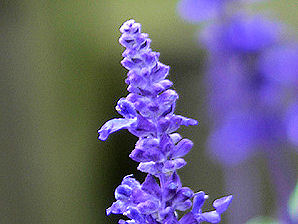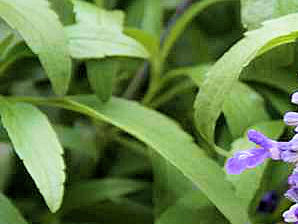Xeriscape Landscaping Plants For The Arizona Desert Environment.
Pictures, Photos, Information, Descriptions,
Images, & Reviews.
Perennials.
Mealy Cup Sage, Salvia farinacea.
We Are Proud Of Our SafeSurf Rating!
Click On Any Of The Following Links By Amazon.Com
For Books, & Videos About Wildflowers Of Arizona & The Southwest USA. No Obligation!
 |
| Mealy Cup Sage, Salvia farinacea. |
|---|
 |  |
| Flowers. Mealy Cup Sage. Salvia farinacea. | Leaves. Mealy Cup Sage. Salvia farinacea. |
|---|
 /
/

Mealy Cup Sage. Salvia farinacea, Mint Family: ( Lamiaceae ) ( Labiatae ), Mealy Cup Sage. Also Called: Victoria Sage, Mealycup Sage, Blue Sage, 'Victoria Blue' Sage, 'Texas Violet' Sage, Flowering Sage. We wish to thank Wikipedia, the free encyclopedia for some of the information on this page. We share images and information with Wikipedia. Mealy Cup Sage is a herbaceous perennial. Mealycup sage or Victoria Sage, as this plant is more commonly called; bears multiple spikes of blue flowers over a long season starting in the spring. Its leaves are long and toothed, soft and light green to silverish, especially at the undersides. It attracts butterflies and hummingbirds.
Quick Notes:
Height: Up To 1 to 1 1/2 to 4 feet tal, about 12 inches widel.
Flowers: Multiple spikes of blue flowers.
Stalk: Several erect, sparsely leaved stems with pinkish-lavender, bilaterally symmetrical flowers in a long, open, interrupted cluster.
Blooming Time: March -November.
Leaves: Opposite, decussate, petiolate. Petioles to 1.5cm long. Blade coarsely serrate, acute, +6cm long, +2cm broad, lanceolate, appressed pubescent, punctate.
Found: The USDA claims it is native to the USA (CT, FL, LA, NM, OH, OK, TX). The plant is also found in Mexico in the states of Chihuahua, Coahuila, Durango, Nuevo Leon, & Tamaulipas
Elevation: 0 - 5,000 feet.
Hardiness:
Soil pH requirements:
Sun Exposure:
Habitat: Chalky/alkaline, Dry, Sandy, Well-drained/light soils, sandy washes.
Miscellaneous: Photos Taken February 21, 2008. Glendale, Arizona. Drought-tolerant; suitable for xeriscaping.
|
We Are Proud Of Our SafeSurf Rating!



We Are Proud Of Our SafeSurf Rating!
Click On Any Of The Following Links By Amazon.Com
For Books, & Videos About Xerioscape Plants Of Arizona & The Southwest USA. No Obligation!
Click On Any Of The Following Links By Amazon.Com
For Books, & Videos About Wildlife Of Arizona & The Southwest USA. No Obligation!
Back To Arizona Xeriscape Landscaping Main Page.
Back To Xeriscape Perennials Page Four.
Back To Arizona Wild Flowers Home Page
Back To DeLange Home Page
© 1966 - Present, Audrey, Eve, & George DeLange
| © 1966 - Present, Audrey, Eve, & George DeLange |


